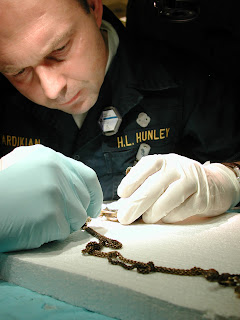Of the myriad personal belongings discovered among the remains of the crew of the Confederate submarine H.L. Hunley, it seemed one piece in particular could help establish or affirm a timeline for the vessel’s disappearance.
That hope thus
far hasn’t panned out.
The hands of
the gold watch belonging to Capt. George Dixon, commander of the eight-man crew,
stopped at 8:23 – at least 20 minutes before survivors of the USS Housatonic,
the Union ship sunk by the Hunley, say the moonlight attack occurred.
For the first
time, beginning this weekend, the public will get its first look at the meticulously
conserved watch and chain.
They are in a
display case at Clemson University’s Warren Lasch Conservation Center in North
Charleston, S.C. “Treasures of the Past” includes jewelry Dixon kept in his
pockets and a disfigured gold coin that absorbed a bullet during the April 1862 fighting at Shiloh and
saved his leg.
A Friends of the Hunley news release on the exhibit outlines
questions surrounding the watch.
“The watch could help answer a lingering mystery: How
long did the crew survive after the sinking of the USS Housatonic? If Dixon set his timepiece accurately before entering the
submarine, the watch represents the first opportunity to place a timeline on
events that transpired the night of the attack.”
 |
| Watch hands are at 8:23 (Photos courtesy of Friends of the Hunley) |
The Hunley then disappeared beneath the waves and entered the realm of legend. To this day, historians, scientists and others debate what caused it to end up on the ocean floor. While one researcher says the crew died from torpedo blast injuries, others say the sinking may have been caused by other factors.
Discovered
a few miles off Charleston in 1995, and raised in 2000, the Hunley is
being conserved at the Lasch Center. The interior of the vessel was a time
capsule, and conservators recovered items and human remains from mud and silt.
Dixon’s watch would have helped the crew time their mission to ride the tide out and back to land without having to propel the hand-cranked vessel against the currents, the Friends of the Hunley say. It would have stopped working if it was wet or suffered a hard blow from the explosion that night.
Union records show that those on board the Housatonic said
the attack occurred between 8:45 p.m. and 9 p.m.
The Friends of the Hunley said that raises three questions:
-- Did Dixon’s watch work properly?
-- Did Federal forces use the same time as Confederates on
shore? If not, and if the Union forces kept time about 20 minutes ahead, perhaps the
times will line up. Standard time was not instituted in the United States until
about 20 years after the Civil War.
-- Will the watch help solve the mystery of what happened to
the Hunley?
Kellen Butler, president and executive director of the
Friends of the Hunley, told the Picket there is no current active research on
the artifact. But that could change if evidence points to possible conclusions.
 |
| Watch with brooch, ring and gold coin in background (Friends of the Hunley) |
Dixon’s watch is now in a case with other items he carried during the mission: The coin, a ring featuring nine diamonds totaling one carat and a 15-carat brooch with 37 small diamonds. The jewelry was meant to be worn by a man as a statement of wealth and success.
Experts told the Post and Courier in Charleston that the internal mechanism of the watch was made in England in the 1830s or 1840s. The
case may have been fashioned shortly before the Civil War.
Archaeologist Nicholas DeLong told the newspaper the watch
was in pristine condition and its main spring intact, indicating it was working the
evening of the attack.
 |
| The watch was found in Dixon's clothing (Friends of the Hunley) |



No comments:
Post a Comment